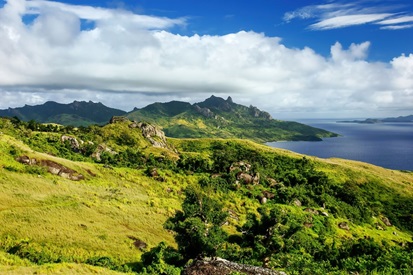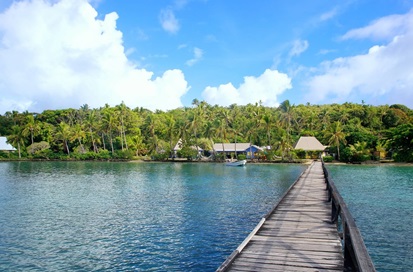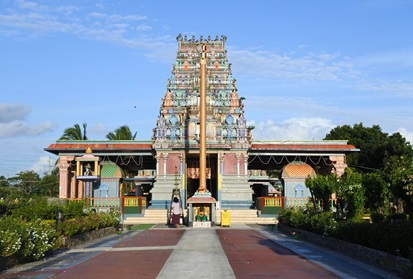

Fiji is a tropical wonderland of crystal clear waters, coral reefs, teeming marine life and swaying palm trees. This is an amazing place where worries just melt away! What do you need to know before heading to a tropical paradise?
Fiji is located in the South Pacific Ocean, approximately halfway between New Zealand and Hawaii, and is part of Oceania. This archipelago consists of 333 islands, of which only about 110 islands are inhabited . From small, incredibly beautiful atoll islands to larger, more mountainous islands with lush tropical vegetation, Fiji offers a variety of landscapes and natural wonders. The main island groups include Viti Levu , Vanua Levu , Yasawa , Mamanuca and Tavuni .
Fiji is famous for its stunning underwater world. Coral reefs frame the islands and create ideal conditions for diving and snorkeling. Tourists can meet colorful tropical fish, turtles, stingrays, and sharks. This is a place where you can explore the richness of the marine world and see it in all its glory.

Depositphotos
Fiji Climate
In Fiji you can enjoy a warm tropical climate all year round: average temperatures are around +25...+30 degrees Celsius. The main seasons in Fiji are the dry season (May-October) and the rainy season (November-April).
Best time to visit Fiji
Experienced people advise going from May to October, or more precisely from May to June and October. It's technically winter in Fiji, but it's the dry season, which means you won't have to deal with cyclones or daily downpours. Cyclones are a serious problem in the South Pacific and can cause enormous damage.
But since May to October has the best weather, it's also the busiest time. Fiji's peak tourist season is July to September due to school holidays in the US, Australia and New Zealand.
If you want to make the most of the good weather and avoid the influx of tourists, the best time to visit Fiji is from May to June or October. And May-June is also the best time to watch whales and manta rays !

Depositphotos
Worst time to visit Fiji
January is the least favorable time to visit Fiji due to the likelihood of cyclones, the bustle of the holiday season and high prices as the New Year approaches.
Summer, or the rainy season, in Fiji lasts from November to April and brings with it powerful cyclones. They can damage roads, hospitals, water infrastructure and airports. Luckily, most resorts in Fiji have clear contingency plans in place.

Depositphotos
Water Activities in Fiji
The underwater world of Fiji is simply breathtaking. The islands are surrounded by crystal clear waters and the coral reefs are dotted with vibrant corals of varying shades. Snorkeling and diving in Fiji are real adventures. You will be immersed in a world of diverse marine life, including colorful tropical fish, turtles, starfish and rare species of coral. Here you can feel like you are in paradise for lovers of the underwater world.
- Beach holiday . Fiji boasts some of the best sandy beaches in the world. Soft white sand, pleasant breezes and warm crystal clear waters create the perfect atmosphere for relaxation and enjoyment. The beaches in Fiji are varied: from secluded and uncrowded to picturesque and lively. Everyone will find here their ideal corner for relaxing under an umbrella or for active pastime on the water. One of Viti Levu's most picturesque beaches , white sand Natadola : a long, wide crescent fringing the emerald sea, is one of the few bodysurfing beaches in Fiji.
- Diving and snorkeling . Immerse yourself in the underwater world, exploring its richness and splendor. Dive sites such as Mamanuca , Rakiraki and Rewa Rewa reefs offer unforgettable experiences and the opportunity to encounter clownfish, turtles, stingrays and other amazing creatures. The soft corals for which Fiji is famous are more common between the larger islands. Diving is excellent all year round, with visibility usually at least 30m. The best months are October and November, after the trade winds have died down, before the start of the rainy season.
- Go kayaking . At almost every resort you will find free sea kayaks for guests. But beware of currents or sudden storms.
- Surfing . Fiji is famous for its perfect waves and is considered one of the best surfing spots in the Pacific Ocean. Limitless beaches and constant winds create ideal conditions for practicing this extreme sport. Among the most famous locations are Klavu-Klavu, Tavarua , Kadavu and others.
- Diving with sharks in Beqa Lagoon . Meet bull sharks and tiger sharks near Beqa Island. Shark feeding has long been a tradition here, with up to hundreds of sharks seen, including reef sharks, silvertip sharks , tawny nurse sharks, sickle lemon sharks, menacing-looking bull sharks and the occasional tiger shark.
- Cruises and excursions around the Fiji Islands . Driving the Coral Coast, loosely defined as the 60km stretch of Queens Road between Short Beach and Pacific Harbour , is perhaps one of the most exciting things to do in Fiji. The Coral Coast has some special attractions and stunning scenery!
Fiji offers a wide range of water sports for anyone who enjoys an active holiday. Explore breathtaking caves, grottoes and lagoons. Rent windsurfing equipment and enjoy the speed and freedom of conquering the waves and wind. If you are into fishing, then deep sea fishing in Fiji will be a real adventure for you. Let out your fishing rod and try to catch a trophy fish.

Depositphotos
Getting to know the holidays and traditions of Fiji
- Local festivals . Fiji has a rich culture and many festivals throughout the year. The population is divided into two demographic groups: the Itaukei (or indigenous) Fijians and the Indo-Fijians , whose ancestors were brought to Fiji by the British to work in the sugar cane harvest. One of the most famous holidays is Fijian Independence Day, which is celebrated on October 10 and is an important event for all Fijians. On this day, parades, dance performances, music concerts and other entertainment take place to immerse yourself in the spirit of the nation. You can celebrate Holi, the festival of colors, in February or March. New Year in Fiji is a special time with lots of beach parties, local traditions, music and dancing - the perfect way to ring in the New Year!
- Take tours of local villages . Visit authentic Fijian villages and learn more about the lives of the local people. You will be welcomed with open arms and introduced to their way of life, traditions and culture. You will be able to visit the houses of local residents, try traditional cuisine and participate in local rituals and ceremonies. As soon as you arrive in the village, excited children shout “ bula !”, elders take the time to shake your hand, and you invariably receive an offer to stay for lunch. There is nothing stopping you from visiting the village unaccompanied. To fully immerse yourself in Fijian life, consider staying overnight in a Fijian village, either with your family or in a purpose-built guest bure owned by the community.
- Visit temples . Fiji's Hindu temples are often the center of colorful festivals, the most spectacular of which takes place at the colorful Sri Shiva Subrahmanya Temple Swami in Nadi. Thaipusam festival at Sri Temple Shiva Subrahmanya The Swami in Nadi brings together thousands of Hindu devotees to celebrate the birthday of Subrahmanya , or Lord Murugan , the god of war worshiped by South Indians.
- A classic Fiji evening - traditional dancing and a feast with roast suckling pig cooked in an underground oven. No evening would be complete without traditional dances, such as Mei (fan dance) and Veka (knife dance), associated with historical events. Legends and tales have been passed down from generation to generation through mehe , and it remains Fiji's most famous form of artistic expression. The lali bamboo flute , drums and stringed instruments create a special atmosphere for festivals and traditional events.
- Stroll through the colorful markets of Fiji . Lively markets sell all sorts of exotic fruits, vegetables and seafood. The markets offer a variety of handicrafts, souvenirs and national clothing.

Depositphotos
Sights of Fiji
- Village of Navala . Fiji's most picturesque village, nestled deep in the highlands of Viti Levu and home to over two hundred traditional handcrafted bures. The village is surrounded by grassy mountains full of secret caves where the townspeople once hid during the war.
- The town of Savusavu , the main tourist center of Vanua Levu , is a small one-street town sandwiched between rolling hills and a silvery bay. Although it's not really a beach destination, it's very popular with boaters, and the nearby Namena Lagoon offers scuba diving.
- Arcing off the coast of Viti Levu , the Mamanucas and Yasawa Islands are a chain of beautiful palm-fringed islands with perfect white sandy beaches, serene lagoons and picturesque resorts. It is Fiji's tourism gem, attracting thousands of visitors.
- City of Levuka . Fiji's most attractive city, a colonial museum full of history and colorful locals. Once a wild whaling outpost, tiny Levuka has grown into a charming seaside town of about two thousand people. Its laid-back atmosphere is embodied in the unkempt, weather-beaten but colorful clapboard buildings . Usually these days these are shops run by Indians.
- Fiji Museum in Suva . Killer stones, cannibal pitchforks and the half-eaten shoe of the unfortunate Reverend Thomas Baker are just some of the most gruesome exhibits in Fiji's best museum! Don't miss out on the chilling history of the islands!
- Sri Shiva Subrahmanya Temple in Nadi. The largest and most impressive temple of Sri Shiva Subrahmanya in the Southern Hemisphere The Swami (also known as the Nadi Temple) dominates the southern part of the city center. The ornate, three-tower Hindu temple, opened in 1994, was built by eight specialist craftsmen imported from India. It took ten years to build it. The temple is dedicated to the deity Murugan , whose statue, specially carved in India, is placed in the main pyramidal vimana , 12 m high, with a rectangular roof. The best time of the year to visit is during the Thaipusam festival in January/February.

Depositphotos
Things to do in Fiji
- Rafting down the river . Rafting down the Navua River to highland villages is a fun way to explore the remote areas of Viti Levu . Be careful, there are some challenging rapids in the upper reaches of the Navua River , but this is the way to enter Fiji's largest and most protected nature reserve.
- Fly on the Zipline in the Gardens of the Sleeping Giant . Sleeping Adventure Park Giant Zipline is an incredible adventure right in the rainforest. There are many Zipline cables installed here, along which you can simply fly through the jungle at a speed of 60 km/h. Feel like Tarzan ! And at the beautiful Orchid Falls waterfall you can not only ride ropes, but also swim in the pools and watch parrots.
- Tour the beautiful island of Vaia and climb to the top for stunning panoramic views! From the west coast , it seems that the face of a giant is peeking out from behind the island: the outlines of the rocky coast are so bizarre. And at low tide you can cruise around Nasilau Point for stunning views of the north coast of Vaya Island .
- Explore the Baum Forest . The vast protected rainforest on the beautiful island of Taveuni is home to native birds, including parrots and the amazing orange pigeon. A wildlife sanctuary with rainforests, waterfalls and home to rare birds and plants - simply a unique experience for a tourist! There are four villages in the park, each with its own eco-attraction : Vaitabu , the first of the villages along the road from Matei, has a protected marine park. Next you will see ancient ruins and come to the beautiful Tavoro waterfall .
- Kula Wild Adventure Park . Amusing eco-park Kula is very convenient for visiting. Walking paths, reptile enclosures and an aquarium with reef fish make exploring the islands fun and safe. The highlight of the park is the large crested iguanas: they are rarely seen, except on a couple of local islands.
- Soak in the hot springs of Sabeto Valley . Most tours include free transfer from Nadi hotels to picturesque gardens with orchids and pools with healing mud. The Tifaek mud pools and hot springs were first discovered in the 1940s when American soldiers used them for bathing. In them you will have the opportunity to immerse yourself in the process of rejuvenation and cleansing of the body: first you need to soak in the warm pools, and then plunge into the black mud. Once dry, plunge into a sulfur-soaked volcanic hot pool to cleanse your skin. Incredible feeling!
- Pamper yourself at the spa . Fiji is not only home to beautiful beaches and nature, but also unique spa resorts that offer the perfect combination of luxury, relaxation and beauty. When you travel to Fiji, you can enjoy unique experiences that attract the attention of tourists worldwide, relax on private islands and villas, and create a romantic and unforgettable experience for your honeymoon or honeymoon. Discover traditional massages using local natural oils and herbs, relaxing baths with floral infusions, as well as exotic therapies such as herbal wraps and stone massages. Indulge in complete wellness and restoration at Fiji's luxury spa resorts .

Depositphotos
What to try in Fiji
Fijian cuisine is a true gourmet feast. It reflects the influence of the various cultures and national groups that live on the islands. The basis of Fijian cuisine is local harvests, including taro root , bananas, coconuts and fish.
If you want to try something traditionally Fijian , ask for grog. It is a local drink par excellence, made from the dried and mashed roots of the Yacona plant . It is known for its calming effect and stimulating effect.
Try lovo (a traditional dish cooked in an underground oven), kokoda (fresh fish soaked in coconut milk, marinated in lemon juice and spices); grilled mahi-mahi fish (deep sea fish cooked on a grill or pan), ruru (a taro leaf dish cooked in coconut milk and served with fish).

Depositphotos
Prices in Fiji
Prices skyrocket during the Christmas and New Year holidays. And February and March are the cheapest times to visit Fiji. It's right in the middle of the rainy season and after the holidays, so there are fewer tourists at this time of year.
Many resorts and airlines are offering better deals to attract more visitors. In general, Fiji's wet season - November to April - is cheaper than the peak dry season.
If you're looking for a low-key holiday in Fiji with a greater chance of good weather, April is your best bet. You won't see as many great deals as in February or March, but the off-season is pretty budget-friendly .
Fiji has accommodation to suit almost every budget. Travelers on a budget can book a hostel from $20 per night. A three-star hotel on the beach will cost about $150-300. There are also luxury hotels that cost a thousand dollars a night. You can even stay on a safari boat while exploring different islands.
The best way to get around Fiji is by bus. Public transport will cost about $8 per day; the cost of taxi trips in Fiji is much higher. Food prices in Fiji can vary depending on the area and restaurants you choose. Based on travelers' shopping habits, the average cost of food in Fiji is around $30 per day.

Depositphotos
Tips before visiting Fiji
- Don't rush anywhere. In Fiji, time seems to stand still. Be prepared for this. If you contact the resort to make a reservation, you may not receive a response for a long time.
- Tours planned on site are often delayed by 30 minutes: you should immediately prepare for this and take a pina colada instead of a sedative .
- Dress modestly and respectfully. When visiting traditional villages, women should cover their shoulders, décolleté and knees. Hats, sunglasses and backpacks are prohibited for everyone. Take them off before entering the village.
- Bring sevuseva . Sevusevu is a gift given to village chiefs upon first entry. In Fiji, kava - or yaqona - is the most common sevusevu . Tourists also bring school supplies and food.
- Take off your shoes before entering the building. In Fiji it is illegal to wear shoes in villages. In the city, people usually wear shoes in shops or other establishments. In the village, take off your shoes at the doors of houses and common buildings.
- Don't make noise in the village. The village in Fiji is a very quiet place. People think of their home not just as their physical home, but as an entire village.
- Do not enter the temple if you have been drinking alcohol.

Depositphotos
How to get to Fiji
The easiest and cheapest flight option is from Seoul with Korean Airlines Air . Flight duration is 9 hours. You can also choose Australia and fly Sydney - Nadi ( Jetstar or Fiji Airways ).
But when planning your route, pay attention to the fact that some connecting countries, for example, the USA or Australia, will require a transit visa. Another option to visit the islands is to take a cruise. Liners operate from Australia, New Zealand and the USA.

Depositphotos
Fiji's geographical position in the Pacific Ocean makes it a unique tourist destination, offering a variety of islands, stunning beaches and a fascinating underwater world. Whether you're looking for adventure at sea or a secluded beach getaway, Fiji promises unforgettable experiences and lasting memories!
More articles
- Rains in Bali: pros and cons of the wet season
- Hotels of Ayana complex in Bali
- Gunung Batur: how to get to the main volcano in Bali
- Likupang on Sulawesi Island in Indonesia
- Mauritius Attractions: 27 Best Places to Visit
- Bali for Two: 24 Romantic Getaway Ideas
- Top 20 Bali Tours: Itineraries, Offers, and Prices
- Bali's Best Beach Clubs - 13 Luxury Oases
- Tips for tourists in Indonesia - how to avoid spoiled holidays
- Yoga Studios in Bali - where to catch Zen on the Island of the Gods



